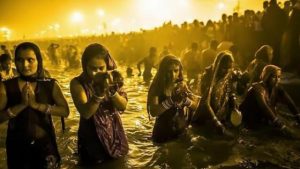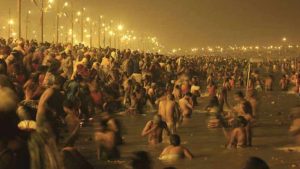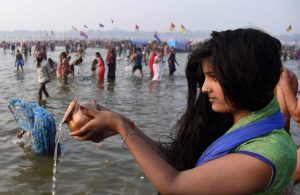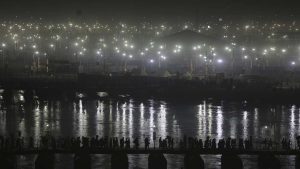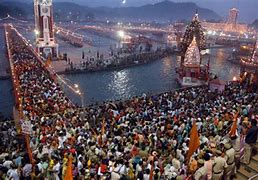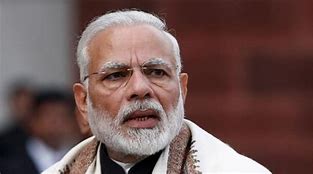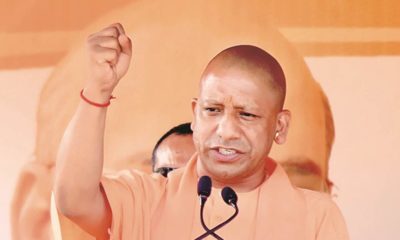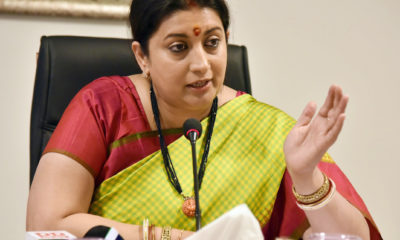Feature
Devotees throng at Kumbh Mela for holy dip on Mauni Amavasya

Allahabad: A sea of humanity swamped the Kumbh Nagari here on Monday as lakhs of pilgrims led by ascetics of Hindu sects took a holy dip on what was the second and most auspicious shahi snan’ on the occasion of Mauni Amavasya.
Traditionally the biggest of all the sacred bathing days in the 50-day long Mela, Mauni Amavasya this time holds greater significance as it falls on a Monday and that too during the Kumbh a rather rare combination on many accounts.
The day began as early as 3 am for many devotees who were seen making a beeline for the Sangam the confluence of the Ganga, Yamuna and the mythical Saraswati — on foot as entry of vehicles was restricted in the vicinity of Kumbh Nagari, the sprawling 32000-hectare township that has come up on the banks of the river.
Yeh Kumbh nahi asan bas itna samajh lijiye thanda pani hai aur dupki lagana hai (Mind you this Kumbh is no easy task, the water is cold and you have to take the plunge), said Ravish Vajpayee, an aspiring poet, who was just out after taking the holy dip in one of the many ghats here.
And though Mauni’ means silent’, the chants of Har Har Ganga’ and Ganga maiya ki Jai’ grew only louder at the break of dawn when Naga Sadhus, a martial order of ascetics who roam naked with ash smeared on their bodies, dancing and singing moved in a procession with religious leaders sitting atop decorated chariots for the holy dip at the Sangam.
Many devotees take up a vow of silence on this day. Sadhus of 13 akharas (seven Shaiva, three Vaishnava, two Udasina, and one Sikh) who have traditionally participated in the Kumbh Mela will be the first to take the holy bath.
Each akhara, the term for an organisation of sadhus, will be allocated 30-40 minutes to participate in the ritual bath by the Kumbh administration. Massive security paraphernalia has been put in place, involving over 40 police stations and as many fire stations to deal with any emergency like situation.
Lakhs of pilgrims takes ‘Shahi snan’ on Mauni Amavasya at Kumbh Mela:
Also, as per officials, for close coordination and prompt communication, an Integrated Command Control Centre (ICCC) and 12 wireless grids have been established. The entire area is under surveillance of 440 CCTV cameras.
Owing to the massive turnout, the ephemeral mega city on Monday, though briefly, could possibly become the most populous place in the world.
In fact due to the huge rush of people, many entry points to the Mela were barricaded by forces. While many complained against it as they were stuck, those who managed to enter were seen boasting of their “breaking cordons” story.
“Do they expect us to go back without taking the dip? One says ‘go there’, the other says ‘this side is blocked’. We are already too tired to put up with this nonsense. Of course, I had to break the cordon ultimately,” said 25-year-old Anshul Gupta from Lucknow.
As per the administration, over 3 crores pilgrims are expected to take part in the mela on the occasion of Mauni Amavasya.
The Kumbh witnesses altogether three ‘Shahi Snans’, the first of which took place on Makar Sankranti (January 15) and the third and the last is scheduled on Basant Panchmi (February 10).
About 12 crore people are expected to visit Kumbh till March 4, when the festival will come to a close.
Entertainment
Meghalaya Reserves Legalized Gambling and Sports Betting for Tourists

The State Scores Extra High on Gaming-Friendly Industry Index
Meghalaya scored 92.85 out of 100 possible points in a Gaming Industry Index and proved to be India’s most gaming-friendly state following its recent profound legislation changes over the field allowing land-based and online gaming, including games of chance, under a licensing regime.
The index by the UK India Business Council (UKIBC) uses a scale of 0 to 100 to measure the level of legalisation on gambling and betting achieved by a state based on the scores over a set of seven different games – lottery, horse racing, betting on sports, poker, rummy, casino and fantasy sports
Starting from February last year, Meghalaya became the third state in India’s northeast to legalise gambling and betting after Sikkim and Nagaland. After consultations with the UKIBC, the state proceeded with the adoption of the Meghalaya Regulation of Gaming Act, 2021 and the nullification of the Meghalaya Prevention of Gambling Act, 1970. Subsequently in December, the Meghalaya Regulation of Gaming Rules, 2021 were notified and came into force.
All for the Tourists
The move to legalise and license various forms of offline and online betting and gambling in Meghalaya is aimed at boosting tourism and creating jobs, and altogether raising taxation revenues for the northeastern state. At the same time, the opportunities to bet and gamble legally will be reserved only for tourists and visitors.
“We came out with a Gaming Act and subsequently framed the Regulation of Gaming Rules, 2021. The government will accordingly issue licenses to operate games of skill and chance, both online and offline,” said James P. K. Sangma, Meghalaya State Law and Taxation Minister speaking in the capital city of Shillong. “But the legalized gambling and gaming will only be for tourists and not residents of Meghalaya,” he continued.
To be allowed to play, tourists and people visiting the state for work or business purposes will have to prove their non-resident status by presenting appropriate documents, in a process similar to a bank KYC (Know Your Customer) procedure.
Meghalaya Reaches Out to a Vast Market
With 140 millions of people in India estimated to bet regularly on sports, and a total of 370 million desi bettors around prominent sporting events, as per data from one of the latest reports by Esse N Videri, Meghalaya is set to reach out and take a piece of a vast market.
Estimates on the financial value of India’s sports betting market, combined across all types of offline channels and online sports and cricket predictions and betting platforms, speak about amounts between $130 and $150 billion (roughly between ₹9.7 and ₹11.5 lakh crore).
Andhra Pradesh, Telangana and Delhi are shown to deliver the highest number of bettors and Meghalaya can count on substantial tourists flow from their betting circles. The sports betting communities of Karnataka, Maharashtra, Uttar Pradesh and Haryana are also not to be underestimated.
Among the sports, cricket is most popular, registering 68 percent of the total bet count analyzed by Esse N Videri. Football takes second position with 11 percent of the bets, followed by betting on FIFA at 7 percent and on eCricket at 5 percent. The last position in the Top 5 of popular sports for betting in India is taken by tennis with 3 percent of the bet count.
Local Citizens will Still have Their Teer Betting
Meghalaya residents will still be permitted to participate in teer betting over arrow-shooting results. Teer is a traditional method of gambling, somewhat similar to a lottery draw, and held under the rules of the Meghalaya Regulation of the Game of Arrow Shooting and the Sale of Teer Tickets Act, 2018.
Teer includes bettors wagering on the number of arrows that reach the target which is placed about 50 meters away from a team of 20 archers positioned in a semicircle.
The archers shoot volleys of arrows at the target for ten minutes, and players place their bets choosing a number between 0 and 99 trying to guess the last two digits of the number of arrows that successfully pierce the target.
If, for example, the number of hits is 256, anyone who has bet on 56 wins an amount eight times bigger than their wager.

